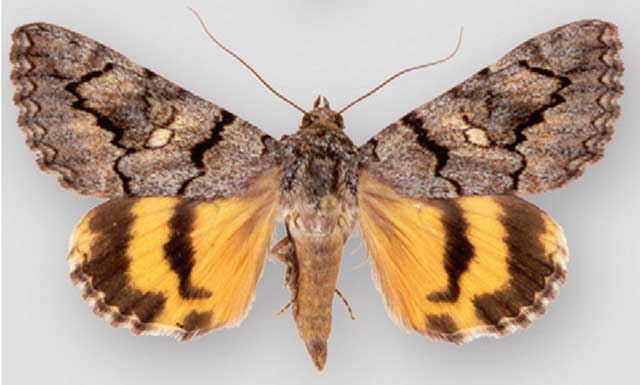Catocala californiensis
kah-TOCK-uh-lahmmkahl-ih-for-nee-EN-sis
Brower, 1976

Catocala californiensis, courtesy of David Hawks.
This site has been created by
Bill Oehlke at oehlkew@islandtelecom.com
Comments, suggestions and/or additional information are welcomed by Bill.
| TAXONOMY:
Superfamily: Noctuoidea
Family: Noctuidae
Group: Noctuinina
Subfamily: Catocalinae
Genus: Catocala, Schrank, 1802
| |
MIDI MUSIC
"Moon River"
copyright C. Odenkirk
MIDI CITYON.OFF
<bgsound src="moon.mid" LOOP=FOREVER>
|
DISTRIBUTION:
Catocala californiensis, the Ashy-gray Underwing,
(wingspan: mm) flies in southwestern
California
along the desert-facing slopes of the Peninsular and Transverse Ranges to the
southeastern edge of the Coast Ranges in Santa Barbara County.
It has also been reported in Ventura, Kern, San Diego, Riverside, San Bernardino, Los Angeles counties.
The northwestern-most populations represent a distinctive new subspecies
(Hawks, in prep.).
"Catocala californiensis is most similar to C. johnsoniana in forewing
coloration, and to C. benjamini mayhewi in hindwing coloration. However, on the
forewing, C. johnsoniana has a conspicuous basal dash (lacking or very small in C.
californiensis), and longer teeth in the postmedial line with a shorter and wider inner
hindwing black band than in C. californiensis." David Hawks.
Look for an evenly ashy gray forewing with black lines. The am line is thick, and the dark patch between
reniform, subreniform, and pm line is usually conspicuous.
FLIGHT TIMES AND PREFERRED FOOD PLANTS:
Catocala californiensis are usually on the wing from mid June
until late August.
"Larvae feed on Quercus cornelius-mulleri at the San Bernardino, Riverside, and San Diego County localities,
and they probably feed on Q. turbinella at the Los Angeles, Kern, Santa Barbara,
and Ventura county localities." David Hawks.
ECLOSION:
Adults eclose from pupae at soil surface.
SCENTING AND MATING:
Catocala californiensis females
emit an airbourne pheromone and males use their antennae to track the
scent plume.
EGGS, CATERPILLARS, COCOONS AND PUPAE:
Eggs are deposited on
tree bark in the fall and hatch the following spring.
Larval Food Plants
Listed below are primary food plant(s) and alternate food plants.
It is hoped that this alphabetical listing followed by the common
name of the foodplant will prove useful. The list is not exhaustive,
although some species seem very host specific.
Experimenting with closely related foodplants is worthwhile.
Quercus cornelius-mulleri .......
Quercus turbinella
|
Mullers Scrub Oak
Shrub Live Oak
|
Return to Main Index
This page is brought to you by
Bill Oehlke and the
WLSS. Pages are on space rented from Bizland. If you would like
to become a "Patron of the Sphingidae/Catocala Sites",
contact Bill.
Please send sightings/images to Bill. I will do my best to respond to
requests for identification help.

Catocala californiensis Ventura County, California,
All Leps Barcode of Life.

Catocala californiensis Ventura County, California,
All Leps Barcode of Life.

Catocala californiensis Ventura County, California,
All Leps Barcode of Life.
Visit Catocala delilah Species Complex; Author: David Hawks.
Visit California Catocala
immatures



